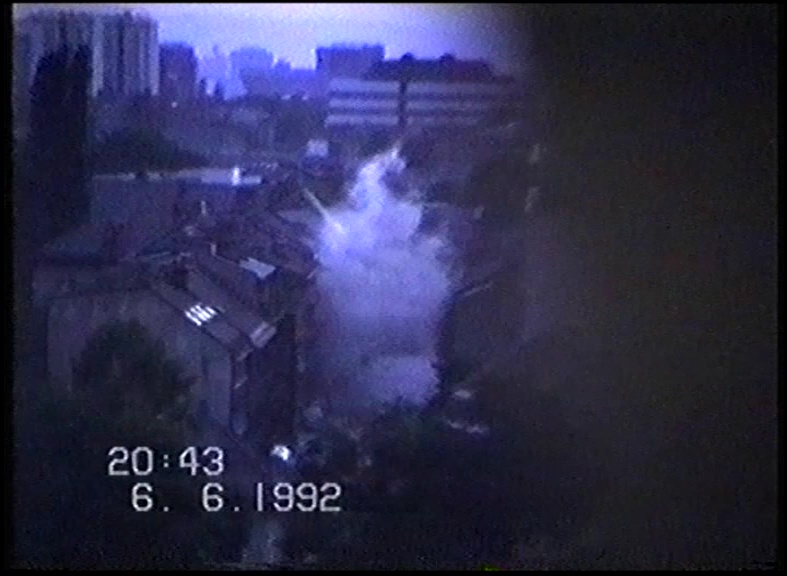
Sarajevo
In Sarajevo (Bosnia and Herzegovina), the focus is on microstories, visual collections from various neighborhoods, and public spaces that play an important social role in Sarajevo, including life during the siege (1992 – 1996).
Archival Holdings, Sarajevo:
– The Library Hamdija Kreševljaković Video Arhiv Sarajevo
– The Un-War Space Archive
– The Historical Museum of Bosnia and Herzegovina
– Additional Materials and Interviews
Documents from the Library Hamdija Kreševljaković Video Arhiv Sarajevo
Index: Collection/ Holding – Document type (V-Video, P-Photograph, G-Graphic, T-Text) – Location (B-Belgrade, M-Mostar, P-Prizren, S-Sarajevo) – Sequential number
The Library Hamdija Kreševljaković Video Arhiv Sarajevo is a collection of video testimonies recorded by the citizens of the besieged city of Sarajevo, Bosnia and Herzegovina (1992 – 1996). In response to the aggression, friends around siblings Nihad, Sead Kreševljaković, and Nedim Alikadić began documenting their everyday lives as they drew on their pre-existing video practice. They produced essayistic film commentaries and fictional miniatures that critically examined their situation. Subsequently, they created a video archive and a space to share and discuss this material.
Save the Amazon Production, emerging from the Video Arhiv Sarajevo, is a loose constellation of amateur filmmakers who began making fiction films in besieged Sarajevo. They called themselves Save the Amazon Production. A T-shirt gave the name a witty commentary on the fact that no one saved them, but also a reminder that no struggle can be waged alone (Alikadić, Kreševljaković in an interview with C. Thieme, 2023). Their films, inspired by the famous pre-war Sarajevan comedy show Top Lista Nadrealista, were characterized by absurd plots, sci-fi borrowings, and gallows humor, refusing to give up hope or succumb to nationalist ideologies. In their playful collective approach, they created an imaginary survival space resisting war violence.
Documents from The Un-War Space Archive
The Un-War Space Archive is an open archive that contains numerous video and sound documentation, photos, architectural drawings, and the Un-war Lexicon. Still, it is purposely left unfinished to receive new testimonies and politically position the necessity of collective (re)thinking of the war in Sarajevo, Mostar, or any other violent conflict. The authors of the photos, videos, and other documents are citizens and specialists such as photographers, architects, journalists, and others. The Un-War Space archive is part of the practice of the Un-war Space lab, founded in 2016 by the architect and researcher Armina Pilav. Un-war Space Lab – a fluid collective of architects, an archeologist, and intermedia artists researching, spatially and virtually exposing ecologies of violent transformations on the entanglements of the war (violent ) and un-war (non-violent) spaces. The archive consists of:
– Un-War Space Drawings / Destructive metamorphosis (Zoran Dorsner 1994)
– Un-War Space Videos / The videos of ‘Sarajevo Diary: from Bad to Worse’
– Un-War Space Photos
Documents from the Historical Museum of Bosnia and Herzegovina
The Historical Museum of Bosnia and Herzegovina is a place of dialogue about the past, critical thinking, learning, and encounters. Through continuous research on numerous topics from the turbulent history of the 20th century, the museum opens up to a diverse local and international audience. In the process of preserving and presenting the heritage of the Second World War, socialist Yugoslavia, the war in Bosnia and Herzegovina, and the Siege of Sarajevo, the museum often speaks from the perspective of the ordinary person. The museum contributes to the development of culture and memory through cooperation with the local community. With a policy of openness to society and active participation in sustainable peace-building, the museum acts as a dynamic platform in overcoming important social issues.
The Path of Life
The ARchipelago features several short videos related to the exhibition “The Path of Life” at the Historical Museum of Bosnia and Herzegovina. “The Path of Life” as the main communication route on the line Novi grad-Novo Sarajevo-Centar, was established to avoid the Sniper Alley, probably the most important reference point on the map of besieged Sarajevo. The new lifeline of the besieged city started from Kranjčevićeva street, then behind the “Maršal Tito” barracks, to the Pofalići settlement in Novi Sarajevo, behind the Energoinvest building, Marka Marulića, Paromlinska street and further towards Novi Grad. Citizens moved along the Path of Life every day, whether going to work, returning home or in search of basic survival needs. Traffic functioned on it, life took place on it.
The unfolding of life and activities on the Path of Life not only depicts the life of citizens under siege but also speaks to the physical transformation of the city. What did it mean to move only a few hundred meters from the main city road? Today, one of the streets in the Municipality of Novo Sarajevo is called „Put života“, one of the rare traces of the existence of this alternative war route.
On the Path of Life, the high-risk zones were: the hinterland of Hastahana, towards the former Military Hospital (General Hospital), the crossroads at Marin Dvor, the hinterland of the Church of St. Josip, the intersection behind the Holiday Inn Hotel, the Technical School, the Energoinvest building, as well as all points of contact with the so-called Sniper alley. These places were marked with the signs “Watch out for the sniper!” as a warning to citizens to be as careful as possible when crossing such dangerous places.
Additional Materials and Interviews
Photo credit above: courtesy of the Library Hamdija Kreševljaković Video Arhiv